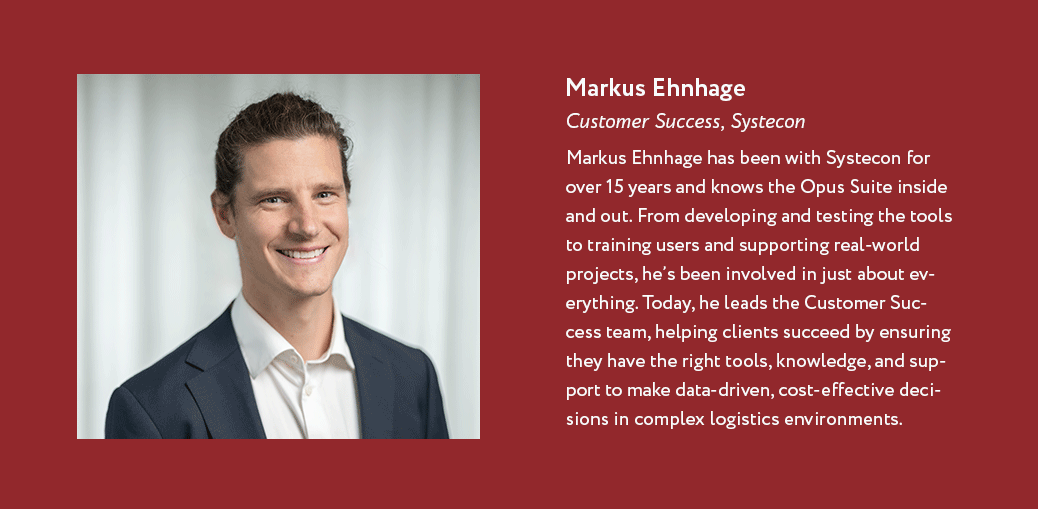

Optimizing Contract Requirements in Defense Logistics: System vs Item Approach with Opus Suite
Within technical systems procurement, operations and maintenance, setting up and understanding contractual requirements is fundamental to success. Whether you're buying and operating the systems, or if you’re the one developing and maintaining them, your everyday work will be influenced by KPIs from the corresponding contracts. The key to effectively meeting these obligations, or coping with the reality they give you at hand, lies in thoroughly understanding what the KPIs truly measure and how they align with planned operational goals.
Let's illustrate this concept using a search and rescue helicopter fleet as an example. For this analysis, a fictional fleet of 20 helicopters have been examined over a 10-year period. When modelling complex systems like helicopters, it's essential to focus on the components that matter. Often, a first filtering can be done by only looking at items that drives system unavailability, has a significant failure rate and a replacement need. In the following scenario, this amounts to 120 items across six different subsystems of the helicopter.
Understanding Fill Rate Requirements
A common contractual requirement in these scenarios is to set a minimum fill rate – for example 90%. But what does this really mean, and how do we calculate it?
Fill rate represents the probability of having a spare part available when requested. We can also assume that this requirement goes for each and every individual item. In a steady-state scenario, it is straight forward to calculate the fill rate for any given number of spare parts by assuming that the number in resupply for a specific item can be described by a Poisson distribution. This approach is often referred to as the "item approach" and it lets us analyse each component separately.
To achieve the 90% fill rate target, we need different stock sizes for each item, depending on its demand and resupply time. For some items, one spare is enough, while other items will require more. But having no spares at all isn’t good enough for any item since an empty stock always will end up with 0% fill rate.
Applying this methodology across all 120 items in our helicopter case, we end up with a spare parts mix where each component has at least a 90% fill rate, resulting in an average fill rate of approximately 93%.
But what if the contract specifies an average 90% fill rate across all items rather than individually? This opens numerous possibilities for meeting the requirement. We could achieve 100% for some items and less for others, still maintaining a 90% average. With 120 items and just two stocking options per item, we'd have 2^120 possible combinations - an astronomically large number that requires algorithmic optimization rather than spreadsheet calculations.
The System Approach: Balancing Cost and Performance
To choose between these alternatives, we need an additional criterion - most importantly, cost. If we can minimize the total cost of buying and owning spares while meeting contractual targets, we create value for all stakeholders. This "system approach" allows us to prioritize between items, accepting higher risk for rarely requested components while investing more in frequently needed ones.
Systecon's Opus Suite enables this sophisticated analysis through its advanced algorithms. Using Opus Suite, we can rapidly distinguish between millions of potential scenarios to find the optimal spare parts mix that meets contractual requirements at minimum cost.
The difference between the results produced by these approaches is substantial. When comparing the item approach (where each component must meet 90%) to the system approach (optimizing for a 90% average), we get a dramatically different spare parts mix. Looking at the results from the system approach, the spread of the fill rate per individual item is much wider. Some items drop below 90%, or even to 0% (meaning we choose not to stock them at all), while others are prioritized resulting in an increased investment and hence a fill rate exceeding 90%.
When we factor in costs - including purchase, storage, and transportation expenses - the benefits become clear. Using the system approach with Opus Suite while maintaining the same 93% average fill rate could reduce costs from €65 million to €37 million - approximately 40% savings. Alternatively, keeping the same €65 million budget but optimizing via the system approach could increase the average fill rate from 93% to 99%.
These findings also align with established research. Logistics engineering experts, like the late Mr. Craig C. Sherbrooke, have demonstrated that transitioning from an item to a system approach typically saves 20-30% on initial spares costs. While real-world scenarios may include exceptions and extraordinary events, Opus Suite's sensitivity analysis and "what-if" scenarios help ensure solution robustness.
Beyond Fill Rate: Focusing on Operational Effectiveness
While fill rate effectively measures warehouse performance, it doesn't necessarily reflect operational readiness. It answers questions like "Do we have the part now?" rather than "How many helicopters are ready for takeoff?" or "How many flight hours can we produce annually?".
To address operational effectiveness, we need a different KPI, like system availability – measuring the fraction of systems ready for operation. For example, a contract might stipulate 80% availability, which in our example study would mean that an average of 16 out of 20 helicopters are operationally ready at any given point in time.
When shifting the target KPI from something item-related, to a measure related to the systems, it is important to also shift the optimization objective. In Opus Suite this can be achieved by a single click, allowing for rapid comparisons and sensitivity studies. The result of changing the objective will be a different set of optimal solutions and spares allocations. In our example, the cost of achieving a result where 80% of the helicopters are available, will be substantially lower when using the system optimization approach. Or if we look at the other axis, for the same cost we can increase the availability from 80 to 87% - corresponding to one additional operational helicopter.
The Importance of a Model
What enables these analyses? The short answer is: a robust model in Opus Suite.
Just as crash test dummies simulate accident impacts without endangering humans, our logistics models simulate decade-long fleet operations without waiting for real-world results.
The Opus Suite data model stores information in well-organized, documented structures that facilitate repeatable processes. It defines relationships between data elements and ensures validity through logical connections between components, systems, failure events and maintenance tasks.
Once established, such models enable rapid scenario testing and provides immediate visibility into potential outcomes from changed parameters. With comparatively small efforts - often just minutes - you can update parts of the model and almost instantly visualize how changes will play out across your scenario. The Opus Suite model creates a foundation for contractual evaluations, serving as common ground where stakeholders can agree on assumptions and discuss data anomalies.
Conclusion
Understanding contractual KPIs is essential for effective system support. Through proper analysis with platforms like Opus Suite, these KPIs are made understandable and can be controlled and monitored.
Most importantly, organizations should focus on KPIs that reflect true value creation rather than arbitrary metrics. A well-constructed model in Opus Suite provides the foundation for this understanding, enabling productive discussions between contract counterparts and driving better outcomes for all stakeholders.
Why Choose Opus Suite?
Opus Suite’s integrated approach, advanced simulation and optimization capabilities, comprehensive cost analysis, and robust decision support make it a superior choice for organizations looking to excel in their life cycle management processes. Whether you are managing a single project or a complex portfolio, Opus Suite provides the tools you need to achieve your goals efficiently and effectively.
Book a demo
Related Articles
Optimizing Contract Requirements
Heli-One - Accurate modeling of contract competitiveness
Better PBL Contracts – An Analytical Approach
About the Author




